Understanding Car Insurance Increases After a Not-at-Fault Accident
It’s a common misconception that car insurance premiums only increase after an at-fault accident. The truth is, your rates can still go up even if you’re not the one who caused the collision. This can be a frustrating and confusing situation, especially if you’re already dealing with the stress of being in an accident. In this guide, we’ll explore the reasons why your insurance might increase after a not-at-fault accident and what you can do to minimize the impact on your wallet.
There are a few key factors that can contribute to a premium increase after a not-at-fault accident. One is the insurance company’s “loss ratio” which is the amount of money they pay out in claims compared to the amount of money they collect in premiums. When a high number of accidents occur within a particular area or group of drivers, the insurance company may raise rates to offset the increased risk. Another factor is the “claims history” of the driver. Even if you’re not at fault for an accident, simply having a claim on your record can make you a less desirable risk in the eyes of the insurance company. This is because they view you as more likely to be involved in future accidents, even if that’s not the case. Finally, the type of accident you were involved in can also affect your rates. For example, if you were hit by an uninsured or underinsured driver, the insurance company may have to pay out more to cover your damages. This can lead to a higher premium increase than if you had been involved in a collision with a fully insured driver.
While it’s frustrating to see your insurance rates go up after a not-at-fault accident, there are a few things you can do to minimize the impact. First, make sure you have a copy of the police report and any other documentation related to the accident. This will help you prove that you were not at fault and may help to reduce the amount of the increase. Second, contact your insurance company as soon as possible after the accident and file a claim. This will help to get the process started and may also help to reduce the amount of time it takes for your rates to go back down. Finally, shop around for different insurance companies. There are many different insurance companies out there, and each one has its own set of criteria for determining rates. It’s possible that you may be able to find a better deal with another company after a not-at-fault accident.
Car Insurance Increase After Accident Not at Fault: Why It Happens and What You Can Do
Even if you’re not responsible for a car accident, you might be surprised to find your insurance rates have gone up. This can be frustrating, but it’s important to understand why it happens and what you can do about it.
Reasons for the Increase
Insurance companies use various factors to determine rates, including:
- Your driving history
- The type of car you drive
- Your age and location
- Your credit score
After an accident, even if you’re not at fault, your insurance company may view you as a higher risk. This is because they’re concerned that you might be more likely to file a claim in the future.
Here are some specific reasons why your insurance rates might increase after an accident, even if you’re not at fault:
Increased Risk Assessment
Insurance companies assess your risk based on several factors, including your driving history. An accident, even if it wasn’t your fault, can raise a red flag for insurers. They may view you as a higher risk to insure, leading to premium increases.
Imagine this: An insurance company might reason that even though you weren’t at fault in the accident, you were still involved. This suggests that you may be more likely to encounter similar situations or make driving decisions that increase the likelihood of future accidents.
Unfortunately, insurance companies often take a broad view of risk, which means that an accident on your record, regardless of fault, can impact your premiums.
Statistical Data and Industry Trends
Insurance companies rely heavily on statistical data to determine their rates. Studies have shown that drivers who have been involved in accidents, even not-at-fault ones, have a higher probability of filing claims in the future. This data influences insurers to adjust premiums accordingly.
Think of it this way: If a large number of drivers with a history of not-at-fault accidents file subsequent claims, insurance companies may conclude that there’s a correlation between such accidents and future claims. As a result, they may increase premiums for all drivers with similar accident histories.
While this approach may seem unfair to individual drivers who weren’t at fault, insurers argue that it’s necessary to maintain a balanced risk pool and ensure the solvency of their operations.
Car Insurance Increase After Accident Not at Fault? Here’s What You Need to Know
We’ve all been there: you’re driving along, minding your own business, when suddenly, bam! Someone rear-ends you. It’s not your fault, but now you’re worried about your insurance rates going up. Can that really happen?
The short answer is: yes, in some cases, your insurance rates can increase after an accident that wasn’t your fault. It’s not always the case, but it’s something to be aware of.
Company Policies and Regulations
Each insurance company has its own policies and regulations regarding rate adjustments after accidents. Some companies may have a blanket policy of raising rates for all accidents, regardless of fault. Others may only raise rates if the accident was determined to be your fault. Still others may consider factors such as the severity of the accident, the number of accidents you’ve had in the past, and your driving record.
Factors That Can Affect Your Rates
In general, there are a few factors that can affect whether or not your rates will go up after an accident, even if it wasn’t your fault. These factors include:
- The severity of the accident: A minor fender bender is less likely to cause a rate increase than a major accident with injuries or fatalities.
- Your driving record: If you have a history of accidents or traffic violations, your rates are more likely to increase after an accident, even if it wasn’t your fault.
- The insurance company’s policies: Some insurance companies are more likely to raise rates after an accident than others. It’s important to read your policy carefully and understand the company’s rules regarding rate adjustments.
What You Can Do
If you’re worried about your insurance rates going up after an accident that wasn’t your fault, there are a few things you can do:
- Contact your insurance company as soon as possible after the accident.
- Be sure to provide the insurance company with all of the details of the accident, including the police report and any other relevant documentation.
- Ask the insurance company about their policies regarding rate adjustments after accidents.
- If you’re concerned about your rates going up, you may want to consider shopping around for a new insurance policy.
Conclusion
Getting into an accident, even if it’s not your fault, can be a stressful experience. Dealing with insurance companies and potential rate increases can add to the stress. However, by following these tips, you can help to minimize the impact of an accident on your insurance rates.
Car Insurance Increase After Accident Not at Fault? Here’s What You Need to Know
If you’ve been involved in an accident that wasn’t your fault, you may be surprised to find that your car insurance rates have gone up. This is because insurance companies use a variety of factors to determine your rates, including your driving history, the type of car you drive, and the amount of coverage you have. An accident, even if it wasn’t your fault, can still be a negative mark on your driving record, which can lead to higher rates.
Communication with Your Insurer
The first step after an accident is to contact your insurance company. They will need to know about the accident and the damage to your car. You should also ask your insurance company about the reasons for the increase in your rates. They may be able to explain why your rates have gone up and what you can do to lower them.
Discounts and Reductions
There are a number of discounts and reductions that you may be eligible for, even after an accident that wasn’t your fault. These discounts can help to offset the cost of your insurance and make it more affordable. Some common discounts include:
- Good driver discount
- Accident-free discount
- Multi-car discount
- Homeowner’s discount
- Senior citizen discount
Filing a Complaint
If you believe that your insurance company has unfairly raised your rates, you can file a complaint with your state’s insurance commissioner. The insurance commissioner can investigate your complaint and take action against your insurance company if they find that they have violated the law. You can usually file a complaint online or by mail.
Other Options
If you’re not satisfied with the response from your insurance company or the insurance commissioner, you may have other options. You can:
- Shop around for a new insurance company.
- Increase your deductible.
- Reduce your coverage.
If you’re involved in an accident that wasn’t your fault, it’s important to remember that you have options. You can contact your insurance company, file a complaint, or shop around for a new insurance company. There are also a number of discounts and reductions that you may be eligible for, even after an accident that wasn’t your fault. By taking the time to explore your options, you can find an affordable insurance policy that meets your needs.
Car Insurance Increase After Accident Not at Fault? Here’s What to Know
Car accidents are never fun, but they can be even more frustrating when you’re not at fault. Not only do you have to deal with the hassle of repairs and medical bills, but you may also see your car insurance rates go up. Why does this happen, and what can you do about it? Let’s take a closer look.
Understanding the Why
Insurance companies use a variety of factors to determine your rates, including your driving history, the type of car you drive, and where you live. When you’re involved in an accident, even if it’s not your fault, it can raise red flags for insurers. They see it as a sign that you’re more likely to be involved in another accident in the future, which increases their risk.
Exploring Options to Mitigate the Increase
Just because your insurance rates may go up after an accident that’s not your fault doesn’t mean you have to accept it. There are several things you can do to try to mitigate the increase, such as:
1. Increasing your deductible: A deductible is the amount you pay out of pocket before your insurance coverage kicks in. By increasing your deductible, you can lower your monthly premiums. For example, if you increase it from \$500 to \$1,000, you could save a significant amount of money over time.
2. Improving your driving record: If you have a clean driving record, you’re less likely to see your rates go up after an accident. Taking a defensive driving course or avoiding traffic violations can help you keep your record clean.
3. Seeking non-fault accident forgiveness coverage: Some insurance companies offer non-fault accident forgiveness coverage, which can prevent your rates from going up after an accident that’s not your fault. However, this coverage is not available in all states, so check with your insurer to see if it’s an option for you.
Negotiating with Your Insurer
If you’re not satisfied with the rate increase, you can try to negotiate with your insurer. Explain your case to them and provide evidence that you’re not at fault for the accident. You may be able to get them to reduce the increase or even waive it altogether.
Staying Calm
It’s important to stay calm and not panic if your insurance rates go up after an accident that’s not your fault. There are several things you can do to mitigate the increase and protect yourself from future rate hikes. By following these tips, you can keep your car insurance costs under control and avoid paying more than you should.




Leave a Reply